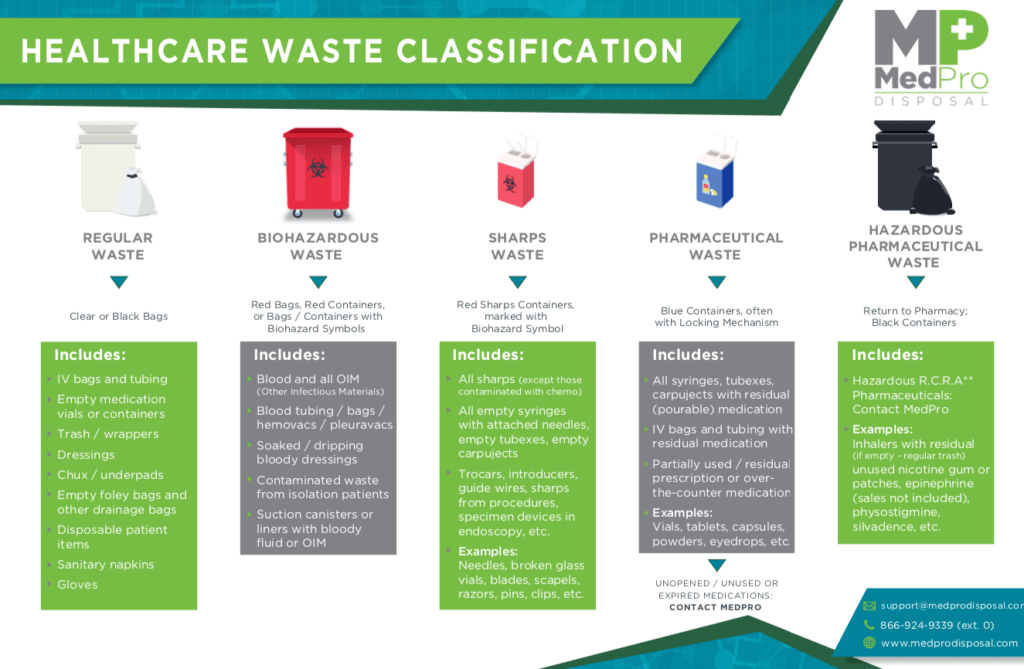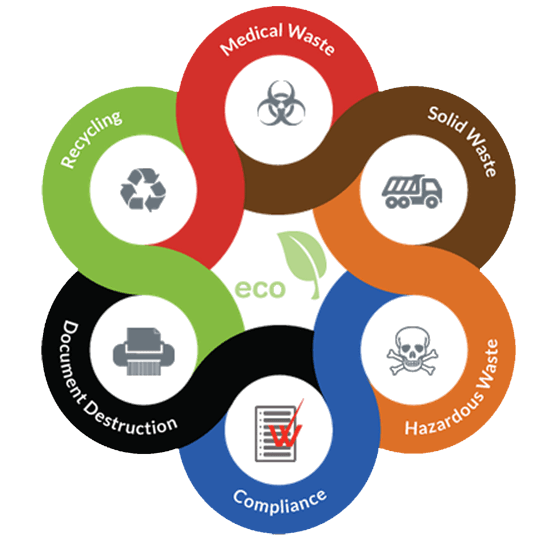Conformity and Laws for Medical Garbage Disposal
Conformity and policies for clinical waste disposal play an important role in ensuring the security and wellness of both healthcare experts and the basic public. Appropriate monitoring of clinical waste is necessary to stop the spread of infections, protect the setting, and keep public health. These regulations incorporate various aspects, consisting of the category and partition of clinical waste, correct storage and dealing with procedures, as well as transport and disposal methods.
Relevance of Conformity
The significance of compliance with laws for medical waste disposal can not be overstated. Correct disposal of clinical waste is essential for guaranteeing the security and wellness of health care workers, clients, and the general public. Medical waste, which consists of things such as used needles, infected handwear covers, and biomedical waste, can pose major health threats if not taken care of and gotten rid of appropriately.
Conformity with policies guarantees that medical waste is taken care of in a method that minimizes the capacity for direct exposure to dangerous compounds and infectious diseases - medical waste removal. It helps protect against the spread of infections, such as HIV, hepatitis B and C, and other bloodborne pathogens. Compliance additionally plays an important function in securing the atmosphere by stopping contamination of water resources, soil, and air
Failure to conform with regulations can cause severe consequences for health care centers, consisting of fines, lawsuit, and damages to their online reputation. In addition, non-compliance might jeopardize the health and wellness of health care employees, people, and the area.
Compliance with policies for medical garbage disposal requires adherence to details guidelines and protocols. These may include proper segregation, product packaging, labeling, and storage of medical waste. It additionally involves making use of approved disposal approaches, such as incineration, autoclaving, or landfilling, depending upon the kind of waste.
Regulatory Agencies and Bodies
Governing firms and bodies play an essential duty in looking after conformity with guidelines for clinical garbage disposal. These organizations are accountable for setting methods, guidelines, and requirements to make sure the appropriate and safe handling of clinical waste. They apply and keep track of conformity to protect public wellness and the environment.
Among one of the most famous governing companies in the United States is the Epa (EPA) The EPA is responsible for managing the storage space, transportation, treatment, and disposal of medical waste. They develop guidelines for waste generators, carriers, and therapy facilities to comply with, ensuring that all necessary safety measures are required to avoid the spread of illness and contamination.
An additional essential regulatory body is the Occupational Safety and Health And Wellness Management (OSHA) OSHA sets policies and standards to shield workers from work risks, including those pertaining to medical waste. WasteX Medical Waste Disposal. They provide guidelines for the secure handling and disposal of medical waste to secure employees in healthcare facilities
Along with these federal firms, private states additionally have their own regulative bodies that supervise clinical waste disposal. These companies may have their own certain laws and demands that have to be adhered to.

Classification and Segregation of Medical Waste
To make certain appropriate monitoring of clinical waste, it is vital to identify and segregate it according to established procedures and guidelines. medical waste removal service. Classification and segregation play an important role in decreasing the danger of infection, shielding the atmosphere, and ensuring the security of healthcare workers and the basic public
Clinical waste is identified into various categories based upon its prospective hazard degree. These categories include contagious waste, pathological waste, sharps waste, pharmaceutical waste, chemical waste, and radioactive waste. Each group requires particular handling, transportation, disposal, and storage methods to decrease the threat of direct exposure and contamination.
Segregation of clinical waste entails dividing various kinds of waste at the resource. This procedure makes sure that waste with different risk levels is not combined, lowering the potential for cross-contamination and making disposal procedures much more efficient. Appropriate segregation is achieved via making use of color-coded containers and tags, which assist medical care employees and waste management personnel identify and deal with each type of waste correctly.
Along with category and partition, health care facilities need to also comply with regional, state, and federal guidelines concerning medical waste administration. These laws describe details needs for storage space, transportation, therapy, and final disposal of clinical waste, making certain conformity and preserving public wellness and safety and security.
Appropriate Storage Space and Dealing With Procedures
Appropriate storage and managing treatments play a critical function in making sure the compliant and risk-free administration of clinical waste. Clinical waste, that includes items such as utilized syringes, infected gloves, and ran out medicines, can posture serious health and ecological threats otherwise taken care of properly. For that reason, it is critical for health care centers and other generators of clinical waste to execute rigorous storage space and handling protocols.
To start with, clinical waste should be kept in sturdy, watertight containers that are especially made for this purpose. These containers must be classified with the global biohazard sign and the words "clinical waste" to clearly suggest the components. In addition, the containers should be kept securely near avoid any kind of possible leakage or spillage.
Moreover, it is essential to segregate different sorts of clinical waste to stop cross-contamination. Sharps, such as scalpels and needles, should be stored in puncture-resistant containers to decrease the threat of injuries - WasteX Medical Waste Disposal. Chemical waste, such as disinfectants and solvents, need to be saved individually from various other sorts of clinical waste to protect against chemical responses or unsafe direct exposures

Transport and Disposal Methods
Healthcare centers need to ensure the safe transport and proper disposal of their medical waste to abide by regulations and safeguard public wellness. Transport and disposal methods play a crucial duty in protecting against the spread of infectious conditions and reducing the environmental effect of clinical waste.
To transport clinical waste, health care facilities must utilize puncture-resistant and watertight containers that are labeled with the biohazard sign. These containers ought to be securely secured to protect against any type of leakage throughout transportation. Additionally, medical care facilities should establish methods for the transportation procedure, consisting of making use of committed cars and skilled personnel.
Once the clinical waste gets to the disposal facility, it undertakes numerous methods of treatment. One usual approach is incineration, which involves melting the waste at high temperatures to destroy microorganisms and minimize the quantity of waste. Another approach is autoclaving, which utilizes heavy steam and pressure to disinfect the waste. After treatment, the waste is normally sent to a land fill or a waste-to-energy facility for last disposal.
It is vital for healthcare centers to work with qualified and allowed waste management business to make certain appropriate transport and disposal of medical waste. These firms have the expertise and resources to manage medical waste securely and in conformity with policies.
Verdict
In final thought, compliance with regulations for medical waste disposal is of utmost significance to ensure public health and wellness and safety and security. On the whole, adherence to compliance and policies is required to properly take care of clinical waste.
Medical waste, which includes things such as used needles, infected gloves, and biomedical waste, can posture severe wellness threats if not managed and disposed of properly.
These groups include infectious waste, pathological waste, sharps waste, pharmaceutical waste, chemical waste, and contaminated waste.Partition of medical waste entails dividing different kinds of waste at the source. Appropriate segregation is attained more helpful hints with the use of color-coded containers and labels, which aid healthcare workers and waste administration employees identify and handle each kind of waste properly.
Chemical waste, such as solvents and anti-bacterials, need to be saved individually from various other types of clinical waste to avoid unsafe direct exposures or chemical responses.